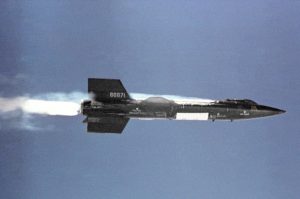 As many of you may have, I first experienced this term in Tom Wolfe’s 1979 book The Right Stuff. As a fan of all things aerospace, I began labeling anything new as “pushing the envelope.”
As many of you may have, I first experienced this term in Tom Wolfe’s 1979 book The Right Stuff. As a fan of all things aerospace, I began labeling anything new as “pushing the envelope.”
Soon it became such a cliche for me that I stopped. Now, in my current First-Year Seminar, “The Space Race,” here I am again, pushing that metahpor into young minds.
First, to understand the term, let’s forget the type of envelope once used to mail bills and letters (remember them?). Instead, we must delve ito the realms of physics, math, and engineering.
A UK phrase finder site that I’m mightily glad to have found gives a nicely succinct and technical explanation of our envelope, but for our purposes, let’s stop at this definition from the OED, “to exceed or extend the boundaries of what is considered possible or permissible; to pioneer or innovate.” They provide a first recorded use in a 1970 aviation magazine, nearly a decade before Wolfe immortalized the term.
The boundaries, in the mathematic sense, are those set by the performance characteristics of normal flight in a particular type of aircraft. Go outside the envelope, and you won’t be flying…you will either push the envelope to a new place for that plane and others who fly it. Or, if you fail, you’ll be tumbling, spinning, breaking apart, crashing. Pilots prefer terms such as “inertial coupling” when talking to the rest of earthbound mortals. As Wolfe related, they might use “auger in” or “screw the pooch” when talking to each other, over a few rounds.
My favorite flying machine that pretty much pushed the envelope so far that its boundaries never fully were know? NASA’s X-15 rocket plane, a potential space vehicle that flew many times for research purposes but never got developed into an utterly cool and fully reusable spacecraft we might have had 20 years before the Space Shuttle. A fellow named Neil Armstrong was known for his journeys to the edge of space in one of them. Many X-15 pilots later earned Astronaut wings. Neil never went quite high enough for that, but he more than compensated on two later space missions, one involving a small step he took.
We can push the envelope in many ways today, but don’t push the envelope of cliche by overusing this one. It has escaped the realm of flight to auger into the earthbound realm of cubicle-land, becoming as “in the box” as the phrase for thinking outside it.
As always, please send us words and metaphors useful in academic writing by e-mailing me (jessid -at- richmond -dot- edu) or leaving a comment below.
See all of our Metaphors of the Month here and Words of the Week here.
Image of the North American X-15 courtesy of Wikipedia.